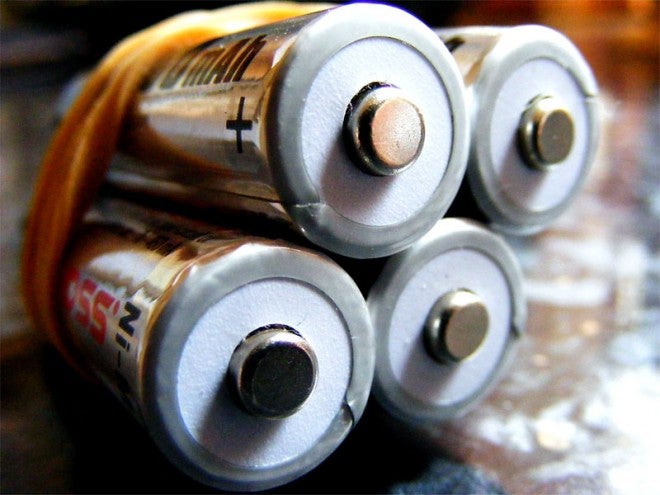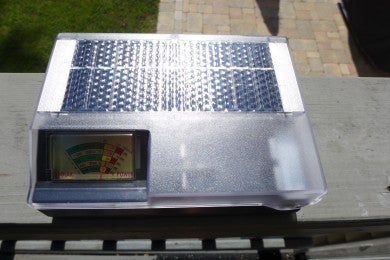Batteries for Bomb Shelters, Part II
Tony Sculimbrene 09.25.13

In the first part of this series, I looked at a little bit of the technical aspects and naming conventions of batteries, as well as at some options for short to medium term storage. Those options will cover you about 90% of the time, but if you’re going someplace where you won’t have electricity for an indefinite period of time, then even the best lithium primary cells won’t work.
You need something else. Here is one game plan.
Let’s suppose that you’re living in a place that has very little reliable power, ever. In that case, even lithiums are delaying the inevitable. Eventually, no matter what you do, they will either discharge completely or run out of juice. Then what? There are, of course, self-powered flashlights, but they’re garbage. Besides, they really only take care of your lighting needs. If you want to run your phone or radio or computer, then you might need something else. In those instances, ironically enough, I’d recommend rechargeable batteries. There are a host of off-grid ways to recharge batteries, and most NiMH and Li-Ion batteries are both low discharge and have tens of thousands of charge cycles. This means that if you have a way of recharging them, they could last you for a very, very long time.
Thinking about this after our editor proposed the article, I did research on a bunch of different options and came to the following conclusion: the most versatile and reliable system would be to use a solar charger, a “power tank”, and a set of good NiMH batteries. This setup could be used to power virtually all of your gear, lights, radios, and phones, for a very long time.
Of course, the reality is that there is no truly indefinite option. Everything wears out eventually, but a good set of NiMHs can be charged, used, and recharged over 1500 times and hold their charge for a time period close to that of a lithium primary (3 years for the NiMH v. 5 years for the Lithium primary). So if you’re using one of the modern power-sipping flashlights that has month-long runtimes on the lowest modes, that means that this system could keep your flashlight working for as close to “indefinitely” as you’d care to get.
Here’s how the components break down.
The Charger
Solar power has been around for a long time, and while it’s “free” in the sense that you don’t need an outlet, it’s expensive to buy and very slow to work. But if you’re in the middle of nowhere, you probably have a surplus of time and a deficit of electricity. In this case, there are a host of solar powered units that will recharge batteries.
You can opt for one that charges only your smartphone, or one that charges regular rechargeable batteries (AAAs, AAs, etc.). Given the increased utility of a multidevice charger, I’d opt for a solar powered battery charger. C. Crane industries was kind enough to send me a charger to try out, the aptly and simply named Solar Battery Charger:
This charger really did work. I picked a pair of AA NiMH batteries and they were charged over the course of a day. The charge times are slow, but again, you’ll probably have a lot of extra time. A pair of AAs charge fully in 15-31 hours. Mine took just about 12, so I imagine they had a little juice left in them.
Two important points though: it only works with NiMH and NiCAD rechargeables, so leave those lithiums at home, and it charges AAAs and AAs in pairs. These are minor limitations though.
The Power Tank
The reason to go with a battery charger instead of a smartphone charger is that you now have juice for your flashlight, walkie talkie, and a radio. Your phone has a built in battery, and really that’s probably the one device you really need. Here, a little extra preparation can solve this problem too. Lots of companies make battery-based external chargers for smartphones, like this one from Energizer. While these devices typically drain rechargeables faster than primaries, if you have a free power source like the Sun, this is not much of a concern.
The other good thing is that a lot of these power tank devices have multiple connectors, which allow you to charge an array of devices from a single power tank. This means that even if you have multiple devices with proprietary batteries, with the right power tank, you can still get them to work. And the beauty of this setup is that you can power all of your devices from the rechargeable batteries that are charged by the Sun. The powerXtender from iGo uses 2xAA batteries, and, with multiple connectors, it can charge just about any device on the planet. (They have a list of compatible devices on the site.) I have an iGo charger, and the connector system works flawlessly. Be quick though because, for whatever reason, the powerXtender is out of production.
The combination of rechargeables, the solar powered charger, and the battery-based external charger gives you a huge amount of flexibility. You can power every device with a single set up. You can use common sized cells to run all of your familiar devices for a very long time, and if you happen upon some primaries, those will work too. This strategy should serve you well for a very long, but not truly indefinite time.
The NiMHs
As far as recommendations for NiMH batteries go, there is no real debate about which are best. For years, flashaholics have proven the superiority of Sanyo’s Eneloop system. They have the longest shelf life for rechargeables, and they have a very high number of charge-recharge cycles that will provide you with a long lifespan. Plus, they even come charged. Finally, they have a bit higher power capacity than most non-lithium primaries.
I have used other NiMH cells, Rayovac and Tenergy to name a few, but none work as well or have as low a discharge rate as the Eneloops. They may be more expensive (only marginally so), but they are the best, long-term battery solution out there.
Conclusion
In the long term, a solar charger, a power tank, and a set of Eneloop NiMH batteries will serve you well for a very long time. There is no truly indefinite solution. All of these things are machines, and machines eventually wear out. But these three things together can keep you stocked with useful electricity for a while.
Somewhere someone is working on a real self-powered flashlight. When it is released, I’ll be the first in line. It’d be nice if it could also charge my cell phone, but until that product is released, the best approach is to use lithiums for medium term, and a solar powered charger for rechargeables in the long term. There is no permanent solution, nothing that will work forever, but the solar powered charger might last five to ten years, depending on how you use it. Hopefully, by that time you’ll have moved to a place with power, power will reach you, or you’ll have learned to adapt to an electricity free life.
